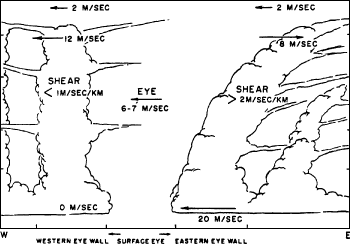

Warm Core MysteryAt about this time, Dr. Robert Simpson of the U.S. Weather Bureau, who had also been a Ph.D. student of Riehl’s, founded the multi-aircraft Hurricane Research Project, based at Palm Beach Florida. Simpson, who had gone on to work at the University of California Los Angeles, was invited to come down and study the new data. With this amazing opportunity, Simpson made new discoveries on how the “eye” of the hurricane works. Before Simpson’s work with Riehl and (Bob) Simpson, meteorologists did not have an understanding of how the “heat engine” inside a hurricane worked. How did hurricanes sustain their tremendous power as they moved over great distances? 
Joanne Simpson (second from right) collaborated with Herbert Riehl (right) and Bob Simpson (second from left) to extend her theories of “hot towers” to hurricanes. Standing in front of Simpson is her daughter, Karen Elizabeth Malkus. (Photograph courtesy Joanne Simpson and the Schlesinger Library) Scientists knew that the eye, or center, of a hurricane was made of a ring of towering clouds around a core of warm air and water, but they couldn’t explain how a core 10-18 degrees Celsius warmer than the surrounding area was created and sustained. Simpson solved an important part of the “warm core” mystery when she applied her “hot-tower hypothesis” to hurricanes. Hurricane winds spray warm water off the tops of ocean waves, and it easily evaporates into water vapor. The heat of the warm ocean water is latent—hidden—in the water vapor. Simpson proposed that a few of the huge cloud towers in the eyewall are active at any one time and that inside these “hot towers” the warm air rises, and water vapor condenses. During condensation, the heat that was latent in the water vapor is released into the upper part of the hurricane eyewall, shedding some of the high energy air into the eye on the way. This process maintains the essential warm core. 
The Tropical Rainfall Measuring Mission (TRMM) provided dramatic confirmation of hot towers in hurricanes when it collected data of Hurricane Bonnie on August 22, 1998. A column of intense rainfall rose to the astonishing altitude of 18,000 meters (59,000 feet)—twice the height of Mt. Everest. (Image courtesy NASA GSFC Scientific Visualization Studio, based on data provided by the TRMM science team.) The release of the latent heat strengthens the low-pressure center in the eye of the hurricane, and winds rush in to fill that low-pressure “void.” The intensified winds suck up more heat and moisture from the ocean. The evaporated ocean water condenses once again into water droplets, replenishing the moisture in the storm clouds, and releasing even more latent heat. Simpson’s “hot-tower hypothesis” explained how this self-sustaining engine can drive the hurricane until it hits land or runs into colder water, or encounters one of the other “hurricane enemies” such as wind shear that can tear the warm core apart. |
| ||
 |

Simpson’s landmark paper, “On the structure and maintenance of the mature hurricane eye,” described the heat transport in hurricanes. (Diagram from Malkus, 1958) As if unraveling the mysteries behind tropical circulation and hurricanes weren’t enough, Simpson also created the first cloud model. “From the beginning my greatest dream was to be able to make a model of a cloud that was either an analytic equation or a computer model,” says Simpson. She says that her first model was a one-dimensional depiction of a buoyant cloud plume growing vertically. At first, she used a slide rule to do the calculations because computers had not been invented. Despite the model’s limitations, Simpson’s work sparked an entire field of study within meteorology. Around the time when she began working on cloud models, there were two or three other people in the field. After only a year or two, there were up to about 350 meteorologists working on cloud models and related observations. The popularity was largely driven by scientific and practical interest in cloud seeding and weather modification. next: The Weather Modification Roller Coaster
| ||